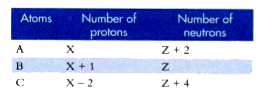Define isotope and isobar.
Step-by-Step Text Solution:
1. Definition of Isotope:
- An isotope is defined as atoms that have the same atomic number (Z) but different mass numbers (A).
- The atomic number represents the number of protons in the nucleus, while the mass number is the total number of protons and neutrons in the nucleus.
- For example, consider the oxygen isotopes:
- Oxygen-15 (O-15) has a mass number of 15.
- Oxygen-16 (O-16) has a mass number of 16.
- Oxygen-17 (O-17) has a mass number of 17.
- All these isotopes have the same atomic number (Z = 8) but different mass numbers.
2. Definition of Isobar:
- An isobar is defined as atoms that have the same mass number (A) but different atomic numbers (Z).
- This means that while the total number of protons and neutrons is the same, the number of protons (which defines the element) is different.
- For example, consider the following isobars:
- Chlorine-40 (Cl-40) has a mass number of 40.
- Argon-40 (Ar-40) also has a mass number of 40.
- Potassium-40 (K-40) has a mass number of 40 as well.
- In these cases, all the atoms have the same mass number (A = 40) but different atomic numbers (Z).
Summary:
- Isotopes: Same atomic number, different mass numbers (e.g., O-15, O-16, O-17).
- Isobars: Same mass number, different atomic numbers (e.g., Cl-40, Ar-40, K-40).
---
- An isotope is defined as atoms that have the same atomic number (Z) but different mass numbers (A).
- The atomic number represents the number of protons in the nucleus, while the mass number is the total number of protons and neutrons in the nucleus.
- For example, consider the oxygen isotopes:
- Oxygen-15 (O-15) has a mass number of 15.
- Oxygen-16 (O-16) has a mass number of 16.
- Oxygen-17 (O-17) has a mass number of 17.
- All these isotopes have the same atomic number (Z = 8) but different mass numbers.
- An isobar is defined as atoms that have the same mass number (A) but different atomic numbers (Z).
- This means that while the total number of protons and neutrons is the same, the number of protons (which defines the element) is different.
- For example, consider the following isobars:
- Chlorine-40 (Cl-40) has a mass number of 40.
- Argon-40 (Ar-40) also has a mass number of 40.
- Potassium-40 (K-40) has a mass number of 40 as well.
- In these cases, all the atoms have the same mass number (A = 40) but different atomic numbers (Z).
- Isotopes: Same atomic number, different mass numbers (e.g., O-15, O-16, O-17).
- Isobars: Same mass number, different atomic numbers (e.g., Cl-40, Ar-40, K-40).
Topper's Solved these Questions
- ATOMS AND NUCLEIBOOK - MBD -HARYANA BOARDCHAPTER - ATOMS AND NUCLEIEXERCISE - SHORT ANSWER TYPE QUESTIONS
44 Videos
- ATOMS AND NUCLEIBOOK - MBD -HARYANA BOARDCHAPTER - ATOMS AND NUCLEIEXERCISE - LONG ANSWER TYPE QUESTIONS
3 Videos
- BOARD QUESTION PAPER (SOLVED) - 2019BOOK - MBD -HARYANA BOARDCHAPTER - BOARD QUESTION PAPER (SOLVED) - 2019EXERCISE - LONG ANSWER TYPE QUESTIONS
4 Videos
Similar Questions
Knowledge Check
Discovries of isotopes and isobars contradict some of the postulates of _ atomic theory
ABohr'sBDalton'sCRutherford'sDThomson's
Differentiate between isotope and isobars.
View SolutionGive three points of distinaction between isotopes and isobars.
View SolutionDifferentiate between isotope and isobars.
View SolutionGive three points of distinaction between isotopes and isobars.
View SolutionIsotopes and Isobars
View SolutionFrom the following table, identify isotopes and isobars.


View SolutionDistinguish between isotopes and isobars, giving one example for each.
View Solution
